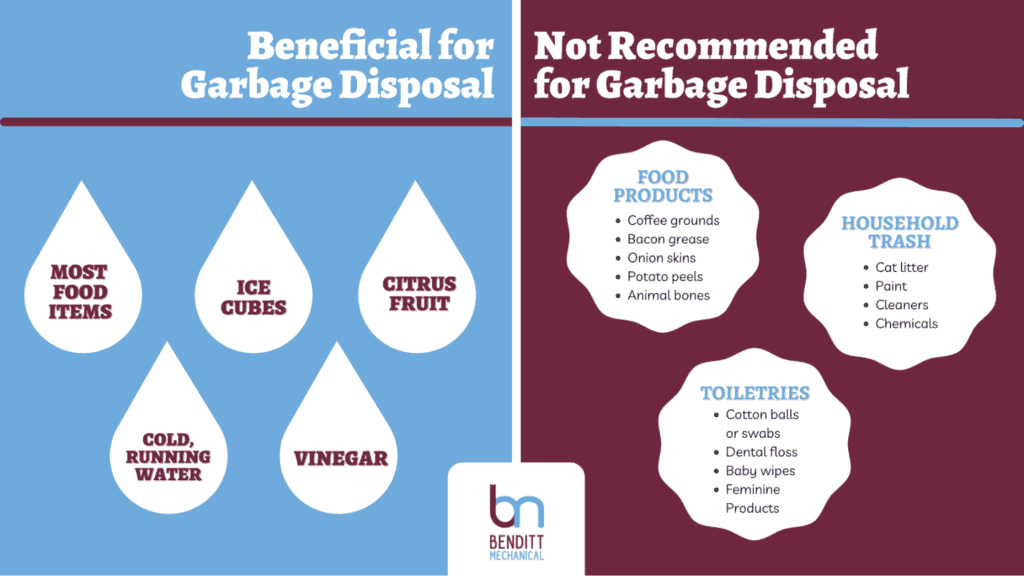Despite popular belief, the garbage disposal in your drain is not a black hole capable of swallowing up any form of matter or material. Like the other appliances in your kitchen, the garbage disposal has a specific use and purpose and requires proper installation and regular maintenance.
A garbage disposal consists of a group of blades between the bottom of the sink and the drain trap. The blades break up debris while running water helps wash it down and through the plumbing. Using a garbage disposal is an environmentally-friendly disposal method and allows for easier cleanup. If you’re a Philadelphia homeowner experiencing garbage disposal issues, we encourage you to contact the professionals at Benditt Mechanical for prompt alleviation.
 What NOT to put in the garbage disposal
What NOT to put in the garbage disposal
Although most liquids and soft foods are suitable for your garbage disposal, the following suggestions offer additional insights into a disposal’s capabilities and limits. Any contents that expand or solidify can clog your plumbing or seriously damage the blades.
Food products:
Most foods are suitable for disposal in your kitchen drain. However, avoid dumping any substances into the garbage disposal that are capable of expanding, hardening, or trapping other particles, such as:
- Coffee grounds
- Bacon grease
- Onion skins
- Potato peels
- Animal bones
Toiletries:
Generally speaking, anything found in your bathroom that isn’t toilet paper should stay away from household drains. Despite the common notion that many hygiene products are “flushable,” all of the following products make pipes more susceptible to clogs.
- Cotton balls or swabs
- Dental floss
- Baby wipes
- Feminine products
Household trash:
We know that garbage disposals are incapable of managing solid, obstruction-prone objects. However, even certain dissolvable or liquid substances should stay clear of the kitchen sink. Similar to food grease, the following materials tend to congeal in pipes and cause blockages over time:
- Paint
- Cleaning chemicals
- Cat litter
Please Note – These precautionary restrictions are not limited to the garbage disposal or kitchen drain. Residents should avoid putting the above products down ANY drain or through any plumbing system.

 What to put in the garbage disposal
What to put in the garbage disposal
Although it has its limits, your garbage disposal can be an incredibly convenient kitchen appliance that cuts waste and cleanup time in half. If well-maintained, its components can last for years without ever needing servicing. The following products can effectively keep your garbage disposal in optimal condition for the foreseeable future:
Cold, running water
Running water while operating the garbage disposal ensures that scraps don’t get lodged in the blades.
Ice cubes
In standard disposal units with blades (as opposed to impellers), tossing a handful of ice cubes down the drain can assist in breaking down accumulated debris.
Citrus fruit
Although seeds and fruit pits should avoid the garbage disposal at all costs, citrus fruit and their rinds can help to simultaneously clean and sharpen the hardware.
Vinegar
Conventional cleaners and drain products can degrade the components of your garbage disposal, leading to costly damage so perform cleaning with natural solutions.
Any Other Food Products
Typically, any cooked leftovers and almost all scraps from fruit, vegetables, and meat are suited for disposal in the kitchen drain. For example, corn cobs, banana peels, and rice (in small amounts) are safe for the garbage disposal. If you’re questioning your appliance’s ability to manage certain types of waste, refer to the above list of products to avoid or feel free to ask our professionals.
Proper Usage of Your Garbage Disposal
Homeowners should regularly maintain and properly operate their garbage disposal unit to ensure optimal function.
- Start by running a steady stream of cold water down the drain before starting the mechanism.
- Turn on the disposal prior to dumping food scraps with the water still running.
- Gradually and carefully add food waste into the disposal slowly.
- Switch off the disposal while still allowing cold water to run through the unit for a few seconds.

Side Effects of Improper Garbage Disposal Use
Despite its name, your garbage disposal can’t handle every piece of trash you throw down the kitchen drain. Improper use of this appliance can cause complicated damage to the blades or motor. Not to be confused with a trash compactor, many of the listed items are too dense or hard for the mechanisms within the disposal (bones and baby wipes) or tend to consolidate and cause a clog over time (grease and paint). Other products cause harm by trapping debris like a net (onion skin and dental floss) or eroding internal parts (chemicals and cleaners).
